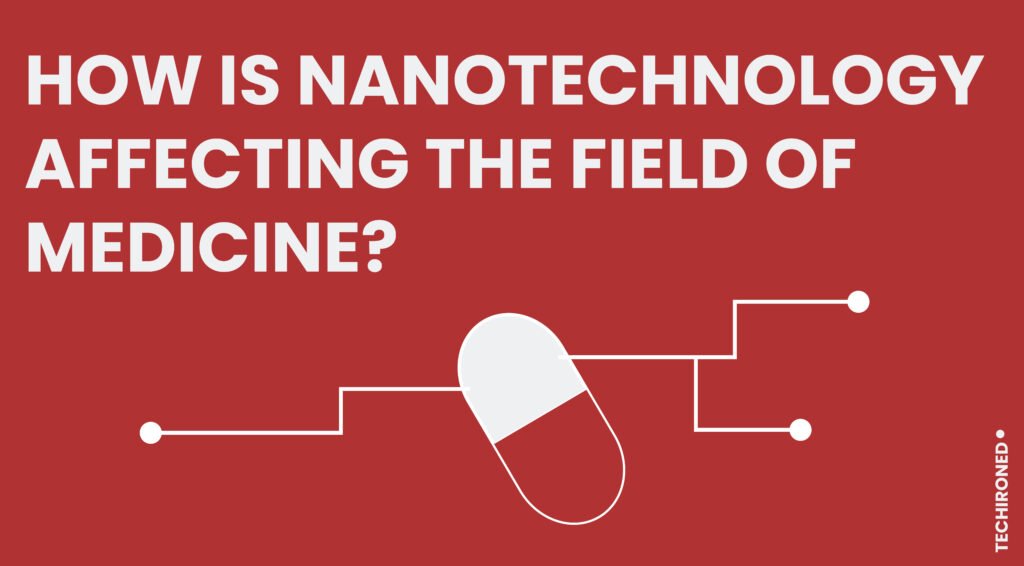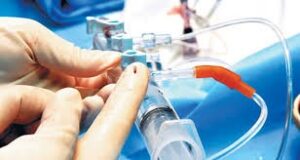Nanotechnology is now affecting the field of medicine in a good way. In our previous blog named Nanotechnology, we have seen the basic structure, applications, and other terms related to Nanotechnology. Now we’ll discuss its application in medicine in a more precise manner. Nanotechnology is used in the field of medicines with the name nanomedicine. Let’s dig into what nanomedicine is. According to the National Institutes of Health (NIH), nanomedicine is “the application of nanotechnology to the prevention, diagnosis, and treatment of disease.” In other words, nanomedicine is the use of extremely small particles (known as “nanoparticles”) to treat or prevent diseases.
You can read all the other nanotechnology related blogs by clicking the following link
https://techironed.com/techironed-blogs/
How Nanotechnology affecting the field of Medicine
(Applications of nanomedicine):
Nanomedicine is still in its early stages, but there are already several potential applications that have been proposed or are under development. These include:
- Developing new methods of drug delivery
- Creating artificial organs
- Developing new methods of imaging
- Diagnosing and treating cancer
- Developing new vaccines
- Generating new tissue for transplantation
- Developing new treatments for neurological disorders
- repairing DNA damage
- And many more…
How does nanomedicine cure cancer:
The use of nanotechnology in cancer treatment is also known as “nano targeted drug delivery”. The idea is to use nanoparticles to deliver drugs directly to cancer cells while minimizing the damage to healthy cells.
This could potentially reduce the side effects of cancer treatments and make them more effective. There are currently several nano targeted drug delivery systems under development, including liposomal drugs, aptamer-based drugs.
Once the nanoparticles have bound to the cancer cells, they can be used to deliver a therapeutic drug directly to the cells. This means that higher doses of the drug can be used, as there is less chance of it damaging healthy cells. In addition, using nanoparticles to deliver drugs specifically to cancer cells may help to reduce side effects.
Several different types of nanoparticles are being investigated for use in cancer treatment, including:
- Liposomes: Liposomes are tiny spheres made from a double layer of fats (phospholipids). They can be used to carry both water-soluble andfat-soluble drugs.
- Dendrimers: Dendrimers are tree-like molecules that can be used to carry both type of drugs.
- Quantum dots: Quantum dots are tiny semiconductor crystals that can be used to target cancer cells and deliver drugs specifically to them.
- Nanoporous silicon: Nanoporous silicon is a type of silicon that has tiny pores in it. These pores can be used to deliver drugs specifically to cancer cells.
- Magnetic nanoparticles: Magnetic nanoparticles can be used to target and destroy cancer cells using magnetic fields.
As you can see, the potential applications of nanotechnology in medicine are vast. And while there are many potential benefits to using nanotechnology in medicine, there are also some potential risks that need to be
considered.
Risks of nanomedicine:
As you can see, several applications of nanomedicine are vast and varied. needs ever, there are also a number of potential risks associated with nanomedicine that need to be considered. These include:
- The potential for nanoparticles to cause damage to cells or DNA
- The potential for nanoparticles to be toxic
- The potential for nanoparticles to be absorbed into the body and cause unintended consequences
- The potential for nanoparticles to be used for nefarious purposes (e.g., developing biological weapons)
There is also the potential for nanoparticles to cause cancer or other diseases. Additionally, there is a concern that the use of nanotechnology in medicine could lead to the development of any nanomedicine applications that must be to current antibiotics.
Given the potential risks, it is important that any nanomedicine applications be developed with safety in mind. For example, nanoparticles should be designed to be biocompatible (i.e., not harmful to living tissue) and
biodegradable (i.e., capable of being broken down by the body).
Despite the potential risks, nanomedicine is a rapidly growing field with many potential applications. There are certain pros to using nanotechnology in medicine such as:
Pros of using nanotechnology in the field of medicine:
Nanotechnology has the potential to revolutionize medicine and healthcare. Nanotechnology can be used to create new and improved medical treatments and diagnostic tools. It can also be used to create new materials
for use in medical devices and implants. Additionally, nanotechnology can be used to create more effective and less invasive methods of delivering drugs and other treatments to patients.
Researchers are actively exploring the use of nanotechnology in medicine and there are already a few commercial products on the market.
Commercial nanomedicine products:
Some examples of commercial nanomedicine products include:
- Nanoparticle-based drug delivery systems
- Nanoparticle-based cancer treatments
- Nanoparticle-based diagnostic tools
- And much more!
The future of nanomedicine is still largely unknown. However, the potential applications of this technology are both exciting and somewhat worrisome.
Unknown factors related to nanomedicine:
As with any new technology, there are always some unknowns when it comes to nanotechnology in medicine. It is unclear at this time what the long-term effects of exposure to nanoparticles might be. Additionally, it is
difficult to predict how nanoparticles will interact with the human body or the environment. As more research is conducted on nanotechnology in medicine, we will likely gain a better understanding of both the risks and benefits
associated with its use. Only time will tell what the future holds for nanomedicine.
Nanomedicine market:
The increase in government funding for nanomedicine research and development and the growing commercial applications of nanomedicine are the major factors driving the growth of the nanomedicine market. However, the
potential risks associated with nanomedicine and the lack of regulatory guidelines are restraining the growth of this market.
The major players in the nanomedicine market are:
- Abbott Laboratories
- F. Hoffmann-La Roche AG
- Johnson & Johnson
- Merck & Co., Inc.
- Novartis AG
- Pfizer Inc.
- Sanofi
- Siemens Healthineers AG
- STADA Arzneimittel AG
- WuXi AppTec Co., Ltd.
By type, the nanomedicine market is segmented into:
- Drugs
- Diagnostics
- Devices
- Others
By application, the nanomedicine market is segmented into:
- Oncology
- Cardiology
- Neurology
- Others
By end user, the nanomedicine market is segmented into:
- Hospitals and clinics
- Diagnostic centers
- Research laboratories and institutes
- Others
By geography, the nanomedicine market is segmented into:
- North America
- Europe
- Asia Pacific
- Latin America
- Middle East & Africa
Conclusion:
After reading this you can understand how Nanotechnology affecting the field of Medicine. Nanotechnology holds great promise for the future of medicine. However, there are also some potential risks associated with nanomedicine that need to be considered. Researchers are actively exploring the use of
nanotechnology in medicine and there are already a few commercial products on the market. The future of nanomedicine is still largely unknown.
What do you think? Comments? Questions? Leave them below!




